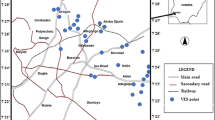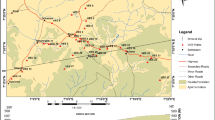Abstract
Sundry soils/rocks are characterized by electrical properties with clearly or obscurely expressed anisotropies. These anisotropic effects may be low, moderate or high depending on the coefficient of anisotropy (λ). The vertical electrical sounding technique employing Schlumberger electrode configuration and lithological information from boreholes were deployed to characterize the lithological diversity in homogeneous and anisotropic geologic units that serve as aquifer systems and their overlaying layers in the coastal region of Akwa Ibom State. Based on the \(\lambda\), the assessed volume of sedimentary formation is classified into low anisotropy λ < 1.2, moderate anisotropy \(\left( {1.2 < \lambda \le 1.3} \right)\) and high anisotropy \(\left( {\lambda > 1.3} \right)\) with alluvium (64.3%), inter-bedded shale and sandstone (14.3%) and shale and slate (21.3%). The estimated percentage of respective compositional coverage indicates that alluvium is dominant, while the blended inter-bedded shale and sandstone as well as the shale and slate are minor geologic units in the Benin Formation. Inferred index of spread of alluvium indicates that the homogeneous and anisotropic units assessed are intrinsic/microscopic in nature as identified by the impressed current that passed through geologic system. The results showcased that the plot between the strike-dependent resistivity \(\left( {\rho_{\theta } } \right)\) at arbitrary chosen strike and geometric mean resistivity \(\left( {\rho_{m} } \right)\) can be used as a yardstick for inferring the degree of consistency of geologic compositions in homogeneous and anisotropic media. Both the quantitative (graphic) and qualitative (contour) results portend the thin possibility of having anisotropy free geologic units. The finding proposes that ground resistivity measurements and interpretations of geologic structures should be constrained by borehole information in order to firm up the intended plans for obtaining clearer, defendable and well-resolved subsurface structures.








Similar content being viewed by others
References
Aissaoui R, Bounif A, Zeyen H, Messaoudi S (2019) Evaluation of resistivity anisotropy parameters in the Eastern Mitidja basin, Algeria, uses azimuthal electrical resistivity tomography, Near Surface. Geophysics 17:359–378. https://doi.org/10.1002/nsg.12048
Akpan AE, Ugbaja AN, George NJ (2013) Integrated geophysical, geochemical and hydrogeological investigation of shallow groundwater resources in parts of the Ikom-Mamfe Embayment and the adjoining areas in Cross River State. Niger Environ Earth Sci 70(3):1435–1456. https://doi.org/10.1007/s12665-0132232-3
Asten MW (1974) The influence of electrical anisotropy on mise a la masse surveys. Geophys Prospect 22:238–245
Bala M (2011) Evaluation of electric parameters of anisotropic sandy-shaly miocene formations on the basis of resistivity logs. Acta Geophy 59(5):954–966
Bala M, Cichy A (2015) Evaluating electrical anisotropy parameters in miocene formations in the cierpisz deposit. Acta Geophys 63(5):1296–1315
Caglar I, and Avsar U (2007) Characterization of electrical anisotropy for cuttability of rocks using geophysical resistivity measurements, near surface in geophysics. In: 13th European meeting of environmental and engineering geophysics, Istanbul, p 3–5
Dachnov WN (1967) Electric and magnetic methods of logging. Fundament of theory, Nedra
Doust H, Omatsola E (1989) Niger Delta. In: Edwards JD, Santogrossi PA (eds) Divergent/passive margin basins, vol 48. Tulsa, American association of petroleum geologists memoir, pp 201–238
Ekanem AM (2020) Georesistivity modelling and appraisal of soil water retention capacity in Akwa Ibom State university main campus and its environs, Southern Nigeria. Model Earth Syst Environ. https://doi.org/10.1007/s40808-020-00850-6
Ekanem AM, George NJ, Thomas JE, Nathaniel EU (2019) Empirical relations between aquifer geohydraulic-geoelectric properties derived from surficial resistivity measurements in parts of Akwa Ibom State, Southern Nigeria. Nat Resour Res. https://doi.org/10.1007/s11053-019-09606-1
George NJ (2020) Appraisal of hydraulic flow units and factors of the dynamics and contamination of hydrogeological units in the littoral zones: a case study of Akwa Ibom State University and its environs, Mkpat Enin L.G.A, Nigeria. Nat Resour Res. https://doi.org/10.1007/s11053-020-09673-9
George NJ, Ekanem AM (2019) Indices of energy and appraisal for electrical current signal at polarising frequency using electrical drilling: a novel approach. In: Sundararajan N, Eshagh M, Saibi H, Meghraoui M, Al-Garni M, Giroux B (eds) On significant applications of geophysical methods: advances in science, technology and innovation (IEREK Interdisciplinary Series for Sustainable Development). Springer, Cham. https://doi.org/10.1007/978-3-030-01656-2_21
George JG, Ekanem AM, Ibanga JI, Udosen NI (2017) Hydrodynamic implications of aquifer quality index (AQI) and flow zone indicator (FZI) in groundwater abstraction: a case study of coastal hydro-lithofacies in South-eastern Nigeria. J Coast Conserv 21(4):759–776. https://doi.org/10.1007/s11852-017-0535-3
George NJ, Ibanga JI, Ubom AI (2015) Geoelectrohydrogeological indices of evidence of ingress of saline water into freshwater in parts of coastal aquifers of IkotAbasi. South Niger J Afri Earth Sci 109:37–46
George NJ, Obianwu VI, Akpan AE, Obot IB (2010) Assessment of shallow aquiferous units and their coefficients of anisotropy in the coastal plain sands of Southern Ukanafun local government area, Akwa Ibom State. South Niger Arch Phys Res 2:118–128
Greenhalgh SA, Marescot L, Zhou B, Greenhalgh M, Wiese T (2009) Electric potential and Frechet derivatives for a uniform anisotropic medium with a tilted axis of symmetry. Pure Appl Geophys 166:673–699
Greenhalgh S, Wiese T, Marescot L (2010) Comparison of DC sensitivity patterns for anisotropic and isotropic media. J Appl Geophys 70(2010):103–112. https://doi.org/10.1016/j.jappgeo.2009.10.003
Hasan M, Yanjun S, Gulraiz A, Weijun J (2019) Application of VES and ERT for fresh-saline interface in alluvial aquifers of Lower Bari Doab, Pakistan. J Appl Geophys 164:200–213
Hill DG (1972) A laboratory investigation of electrical anisotropy in Precambrian rocks. Geophysics 37:1022–1038
Hobbs B, Werthmuller D, Engelmark F (2009) The effect of resistivity anisotropy on earth impulse responses. ASEG Ext Abstr 2009:1–5
Ibanga JI, George NJ (2016) Estimating geohydraulic parameters, protective strength, and corrosivity of hydrogeological units: a case study of ALSCON, Ikot Abasi, southern Nigeria. Arab J Geosci 9:363. https://doi.org/10.1007/s12517-016-2390-1
Ibuot JC, Akpabio GT, George NJ (2013) A survey of the repository of groundwater potential and distribution using geo-electrical resistivity method in Itu Local Government Area (L.G.A), Akwa Ibom State, Southern Nigeria. Cent Eur J Geosci 5(4):538–547. https://doi.org/10.2478/s13533-012-0152-5
Karanth KR (1987) Groundwater assessment, development and management. Tata-McGraw Hill, New Delhi
Karnkowski P (1999) Oil and gas deposits in Poland. Geosynoptics Society (GEOS), Krakow
Kunz KS, Moran JH (1958) Some effects of formation anisotropy on resistivity measurements in boreholes. Geophysics 23(4):770–794. https://doi.org/10.1190/1.1438527
Matias MJS (2002) Square array anisotropy measurements and resistivity sounding interpretation. J Appl Geophys 49:185–194
Matias MJS, Habberjam GM (1986) The effect of structure and anisotropy on resistivity measurements. Geophysics 51:964–971
Obiora DN, Ibuot JC, George NJ (2015) Evaluation of aquifer potential, geoelectric and hydraulic parameters in Ezza North, southeastern Nigeria, using geoelectric sounding. J Sci Technol Int. https://doi.org/10.1007/s13762-015-0886-y
Olasehinde PI, Bayewu OO (2011) Evaluation of electrical resistivity anisotropy in geological mapping: a case study of Odoara, West Central Nigeria. Afr J Environ Sci Technol 5(7):553–566
Onuoha KM, Dim CIP (2017) Developing unconventional petroleum resources in Nigeria: an assessment of shale gas and shale oil prospects and challenges in the inland Anambra Basin. In: Onuoha KM (ed) Advances in petroleum geoscience research in Nigeria, Chapter 16, 1st edn. University of Nigeria, Nsukka, pp 313–328
Petters SW (1989) Akwa Ibom State: physical background, soil and landuse and ecological problems. In: Technical report for government of Akwa Ibom State, pp 603
Short KC, Stauble AJ (1967) Outline of the geology of Niger Delta. Assoc Pet Geol Bull 54:761–779
Thomas JE, George NJ, Ekanem AM, Nsikak EE (2020) Electrostratigraphy and hydrogeochemistry of hyporheic zone and water-bearing caches in the littoral shorefront of Akwa Ibom State University, Southern Nigeria. Environ Monit Assess 192:505. https://doi.org/10.1007/s10661-020-08436-6
Vander-Velpen BPA (1988) A computer processing package for D.C. resistivity interpretation for an IBM compatibles. ITC, The Netherlands, p 4
Vander Velpen BPA, Sporry RJ (1993) RESIST: a computer program to process resistivity sounding data on PC compatibles. Comput Geosci 19(5):691–703
Wei B, Lingwei K, Aiguo G (2013) Effects of physical properties on electrical conductivity of compacted lateritic soil. J Rock Mech Geotech Eng 5(5):406–411
Yadav GS, Singh SK (2007) Integrated resistivity surveys for delineation of fractures for ground water exploration in hard rock areas. J Appl Geophys 62(3):301–312
Yeboah-Forson A, Whitman D (2013) Electrical resistivity characterization of anisotropy in the Biscayne Aquifer. Groundwater 52(5):728–736
Author information
Authors and Affiliations
Corresponding author
Ethics declarations
Conflict of interest
On behalf of all authors, the there is no conflict of interest.
Rights and permissions
About this article
Cite this article
George, N.J., Bassey, N.E., Ekanem, A.M. et al. Effects of anisotropic changes on the conductivity of sedimentary aquifers, southeastern Niger Delta, Nigeria. Acta Geophys. 68, 1833–1843 (2020). https://doi.org/10.1007/s11600-020-00502-4
Received:
Accepted:
Published:
Issue Date:
DOI: https://doi.org/10.1007/s11600-020-00502-4




